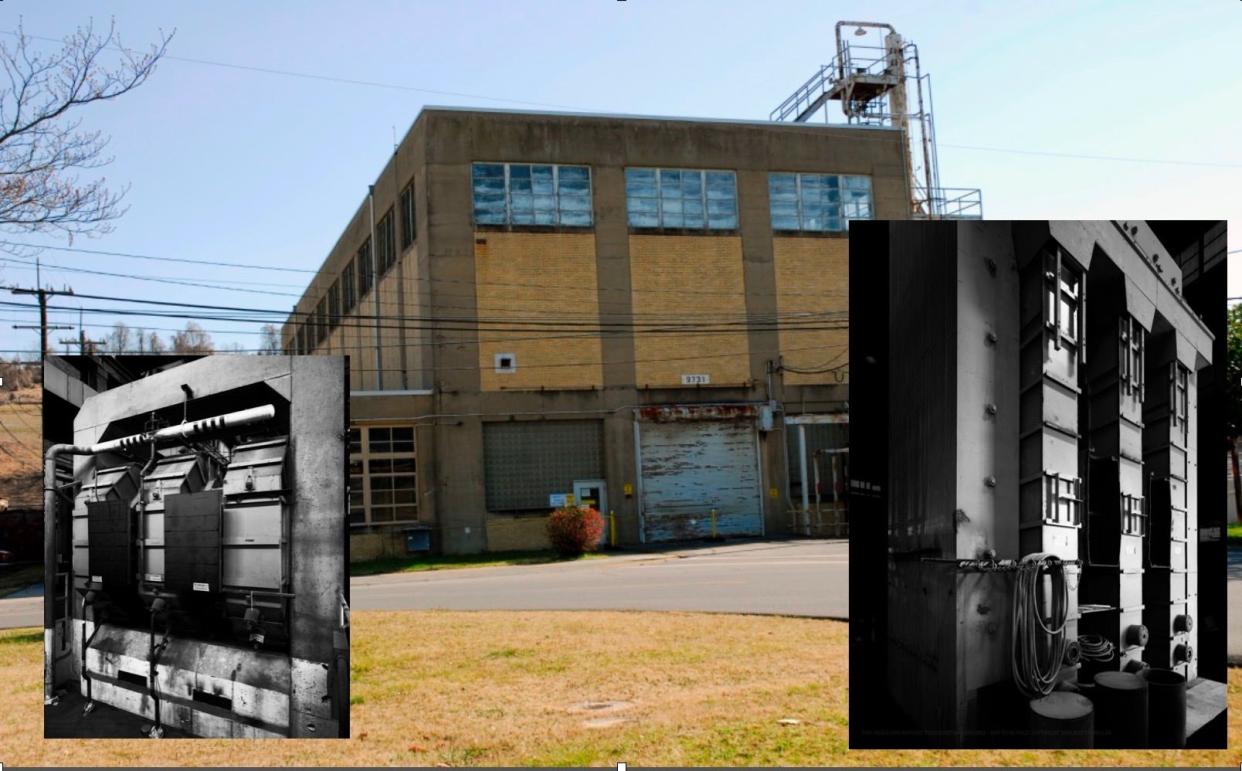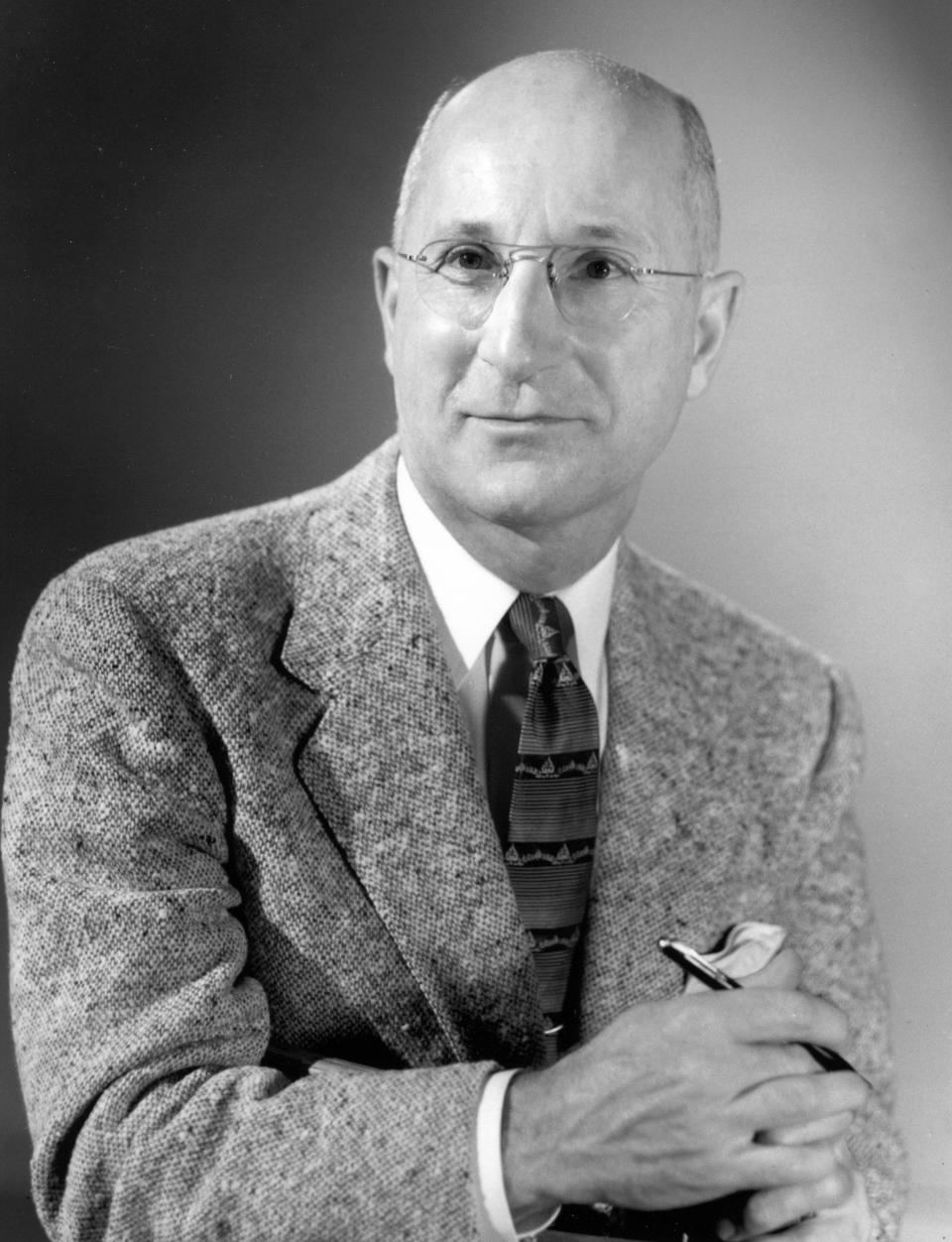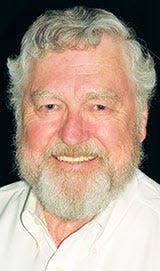Chris Keim and Copper 63; an early Oak Ridger remembers his dad, childhood

I knew Chris Keim after he retired. He convinced me to teach a beginning guitar class at Roane State Community College. My wife, Fanny, worked with his wife at the Bank of Oak Ridge. At the time, I had no idea what he had done before retiring. Amazingly, when I began delving into the history of Y-12 and Building 9731, one of the first things I learned from Gordon Fee was the story about the periodic table that was once in Building 9731.
It seems there was to be a tour of Building 9731 and Gordon knew it was a mess and needed to be cleaned up before the tour. He assigned B.B. Hopkins the task of doing that clean up. Well, clean it up he did and buried what was taken out of the building in a landfill south of Y-12 up on Chestnut Ridge.
The next day, Chris Keim showed up blazing mad at Gordon’s office. He said, “You have just buried the single most important historical artifact in Building 9731, the original periodic table of the elements we separated into isotopes using those historic Calutrons there!”

Gordon sent BB back to dig up the landfill and find that periodic table. It could not be located anywhere. So, I think Chris Keim never forgave Gordon for destroying that historic artifact. I wish it had not been lost as well. Too bad there is not even a photograph of it. There is a really nice wooden periodic table of the elements in Building 9204-3.
Enjoy Bob Keim's memories of his dad, Chris.
***
Dad always talked about how lucky he was to have been at the right place at the right time. He got to Oak Ridge like many other scientists via recommendations by their bosses. Dad was teaching chemistry at Carnegie Mellon and unknown to him at the time, his boss was on the “War Allocation Resources Board,” which was a group that advised the President on how best to produce the goods needed for the war effort. For example, this group decided that Ford would produce B-26 bombers and Chrysler would produce tanks. It obviously helped get the Manhattan Project everything it needed to build Oak Ridge, from bricks at Y-12 to toilets in the houses. It helped decide to use silver (14,700 tons — Ray) from the U.S. Treasury reserves to build the electronic racetracks in the Calutrons.
At one interview, a captain asked Dad if he had any military obligations. Dad answered, “I am to report to Submarine Commanders School in Annapolis this coming June.” The captain made a note in his notebook and said, “Well, that is taken care of.”
Dad used to laugh when he told that story and said, “The captain was sure right about that. I never heard another word from the draft board of the Navy. They wanted me in Oak Ridge.”
After he returned to Pittsburgh, his boss told him, “Do not worry about your classes. Oak Ridge is more important. I will teach your classes if I have to. If you want to go, I want you to go.” A few months later, with a one-year-old baby temporarily left behind, Dad came to Oak Ridge.
Our neighbor, Arthur Snell, ran across a letter of job recommendation to General Groves for his father, Dr. Snell. He was recommended for the job by Enrico Fermi, the famous physicist from the University of Chicago. Dr. Snell brought the Graphic Reactor at X-10 online. It was the first production reactor in the world. It produced the world’s first weapons grade plutonium, which was used in our bomb. He had two offices. One at X-10 and one at Y-12 near Building 9731.
They were building the facilities at Y-12 when Dad arrived. He had gone to school with a kid from Kearney, Nebraska, named Mr. Peterson. Peterson was working on a piece of farm equipment during the summer and needed to hold a long bolt so he could tighten the nut. He invented some locking pliers to hold the bolt for him. When he came back to school, he told Dad that would likely be his last semester because Peterson Manufacturing and his Vise-Grips were selling like hot cakes, and he needed to manage his business.
Dad told the construction people at Y-12 about Mr. Peterson’s invention and asked them to get some. “What model, do we need?” they asked. Dad said, “I don’t know, get us a dozen of each model, he is inventing new ones all the time."
The purchase order for one dozen of each kind of Vise-Grip went from Y-12 to purchasing at Oak Ridge. They said, “If Y-12 needs a dozen, we will get them 2 dozen.” Then up to purchasing for the Manhattan Project where it got doubled again. And so it went, until in a few weeks, a train carload of Vise-Grips arrived at Y-12. To my knowledge, a Vise-Srip never was sold in a surplus auction, and they were still opening boxes of new 1943 Vice-Grips when Dad retired in 1970.
At Y-12 they had run out of ideas about how to enrich the uranium needed for the bomb. One day a visiting professor sat down at one of the calutrons in Building 9731. He twisted the controls and the production of U-235 went up dramatically. The machines could not withstand the new settings and literally started smoking in a few minutes. Building 9731 had a group of electrical engineers, physicists, and chemists who worked for nearly three days without a break re-designing the machine to work with the new settings.
They then turned the improvements over to the draftsmen who made blueprints to hand out to the production departments so they could modify the thousands of other calutrons. Production rose each month as they got more machines modified, so that by June of 1945, they had enough U-235 to make the test bomb in New Mexico, and the two bombs we dropped on Japan that ended the war.
There was a woman who ran a mass spectrograph for Building 9731. A mass spectrograph uses light waves to analyze and identify isotopes. One day she showed Dad that she had detected they had separated a specific isotope of copper (Copper 63). This gave them the idea that they might be able to separate all the isotopes of every element. After the war, a man from Washington asked Dad what it would take to try to do that. Dad said, “Oh a few million dollars a year for 10 years.” The gentleman said, “OK, I will get Congress to give you the money. When can you start?”

And so, the Stable Isotope Division was created at Building 9731.
Ripping their hair out
For the next 10 years Y-12 produced an inventory of all the isotopes to be loaned out and sold for scientific research. The Calutron Girls had jobs that lasted for another 10 years, as they got married, had kids, and retired. Every so often, Dad would come home and say, “Another calutron operator ripped out her hair today and had to go to the hospital.”
Oops, she had forgotten to take all the bobby pins out of her hair. When they turned on the huge magnets, it ripped the bobby pin and some of her hair right off her head.
The medical community was particularly interested in some of the isotopes produced by the Stable Isotope Division. Pretty soon, the MRI was invented and was first called the “Nuclear Resonance Imaging Machine." At the introduction of the prototype, Dad said, “You’d better take the word nuclear out of the name, or nobody will ever get in it.”
Then Thallium 6 was used in EKGs to diagnose blockages in heart muscles and the brains of stroke patients. The staff at 9731 and the calutron operations at Y-12 had contributed to medical advances that have literally saved millions of lives since the war. Now Technetium 99 is used. It has the advantage of giving the patients about one-third the radiation of Thallium 6, which is now less than people get at the dentist getting their teeth X-Rayed. A new reactor and shipping facility is being built in Oak Ridge to produce medical Technetium 99 to be shipped around the world, providing some nice jobs.
When Thallium 6 was first used, it was shipped around the country via Railway Express and might take 10 days to get from Oak Ridge to California. Then UPS sped up the delivery and the shipping times were less. Now FedEx in Memphis ships most of the medical isotopes. Technetium 99 losses its radioactivity twice as fast as does Thallium 6. Accordingly, FedEx allows us to use the new isotope efficiently.
I sent the CEO of FedEx a letter a few years ago and told him how proud I was that a company in East Tennessee at Oak Ridge, and his company in West Tennessee, worked together to save lives around the world while reducing the exposure to radioactivity because of their reliable shipments. He wrote me back and thanked me for letting him know how Tennessee was improving the lives of people around the world, and he would be thinking of Dad when he got his next nuclear EKG. So, the karma of Building 9731 is still being felt in hospitals and cardiologists' offices around the world. Dad would be so proud, as should everyone associated with the research at Oak Ridge.
The lessons learned growing up with nuclear physicists were interesting. Before I was in kindergarten, I asked Dad, as does nearly every kid, “Daddy, why is the sky blue?” I didn’t get a simple answer. I got an explanation of water in the air, humidity and how the water molecules bend the light and make it appear blue — called refraction. A few months later I was at my neighbor’s house and there was a prism on the coffee table. I picked it up, looked at the light coming in the window and said to my friend, “Look Arthur how this glass refracts the light into the colors of the rainbow."
I can remember Dr. Snell whirling around and saying, “Bobby, how do you know that word ‘refraction’?” I proceeded to explain to him how the light was bent by the glass just like it was by the water in the air that made our sky blue. Can you imagine a four-year-old kid lecturing one of the foremost nuclear physicists in the world?
The colors of the rainbow are always in the same order: red, orange, yellow, green, blue, indigo, and violet. That day Dr. Snell introduced me to Mr. Roy G Biv, the letters representing the colors of the rainbow. I was a senior in high school before many of my friends met Roy G Biv in class.
As we now know, Y-12 released tons of mercury into the creek that runs down the middle of town. Dad knew that was happening, but the Defense Department felt it was more important to produce nuclear bombs faster than Russia. However, one Saturday, Dad gathered Mom, my sister and I around the dining room table. He broke a thermometer and let the mercury run onto a piece of glass. He explained that mercury was a metal that was liquid at room temperature, and it could be absorbed through our skin. He told me if I ever saw any, I should mark the spot with rocks like an Indian and then mark the trail out to the road so I could take him back to show him where it was. He never said anything about Y-12. He just wanted us to be safe and to help keep everyone else safe.
I was also not allowed to play in that creek. I could go anywhere else in the city outside the fences, but not that one creek. One day, I was with a friend and jumped across the creek. I didn’t make it all the way and my foot went into the water. I laid awake tossing and turning all night long worried my foot was going to rot off, turn blue or something. Dad asked me why I had been up so many times the night before and I had to confess I had stepped in the creek. We went to the tub and scrubbed my feet with lye soap and a brush. It was 30 years later before I learned the connection between the broken thermometer and the danger in that creek.
We were taught national security and the importance of secrecy from a very young age. By the time I was in high school, I knew three houses of policemen or security officers at the plants that had arsenals in their houses. Not just standard police weapons, but machine guns, bazookas, and a wall full of M-1s. I knew all the police, FBI and plant security officers that went to my church. We were taught for as long as I remember that if I ran across an issue of national security, I was to tell Dad, or one of the appropriate law enforcement officers.
The procedure was for me to simply tell one of the FBI agents after church, “I need to talk to you.” He would then lead me to an empty classroom where I could tell him my concern. In my current job, 40 years later, I have had some contacts with the FBI. I always ask them if the form 201s are still in my file from the '50s. They try to repress a grin, but are usually not very successful.
So, it is funny that many of our views toward the FBI and federal government are different. The FBI was in Oak Ridge to keep all of us and the country safe. We appreciated their efforts. Well, except the “Class of 1965" was painted on the water tower at K-25 for decades. That water tower was behind two 8-foot chain length fences in one of the most secure areas in the country. I hope my classmates who painted the tower confess in their obituaries. Until then, I don’t want to know.
***
Thanks, Bob, for sharing those memories of your dad. The details you recall help provide a better understanding of the importance of the work being done by your dad and others.
The Copper 63 sample that was the first isotope other than uranium to be separated in a Calutron is still in existence today. It was placed in a small plastic container and given to Leon Love as a gift when he retired. His daughter has it in Texas. For several years she loaned it to the Y-12 History Center. It is my hope that she wills that sample to Y-12 for permanent exhibit there at the museum.
Oak Ridge City Historian D. Ray Smith presents a weekly "Historically Speaking" column for The Oak Ridger.
This article originally appeared on Oakridger: Chris Keim and Copper 63

